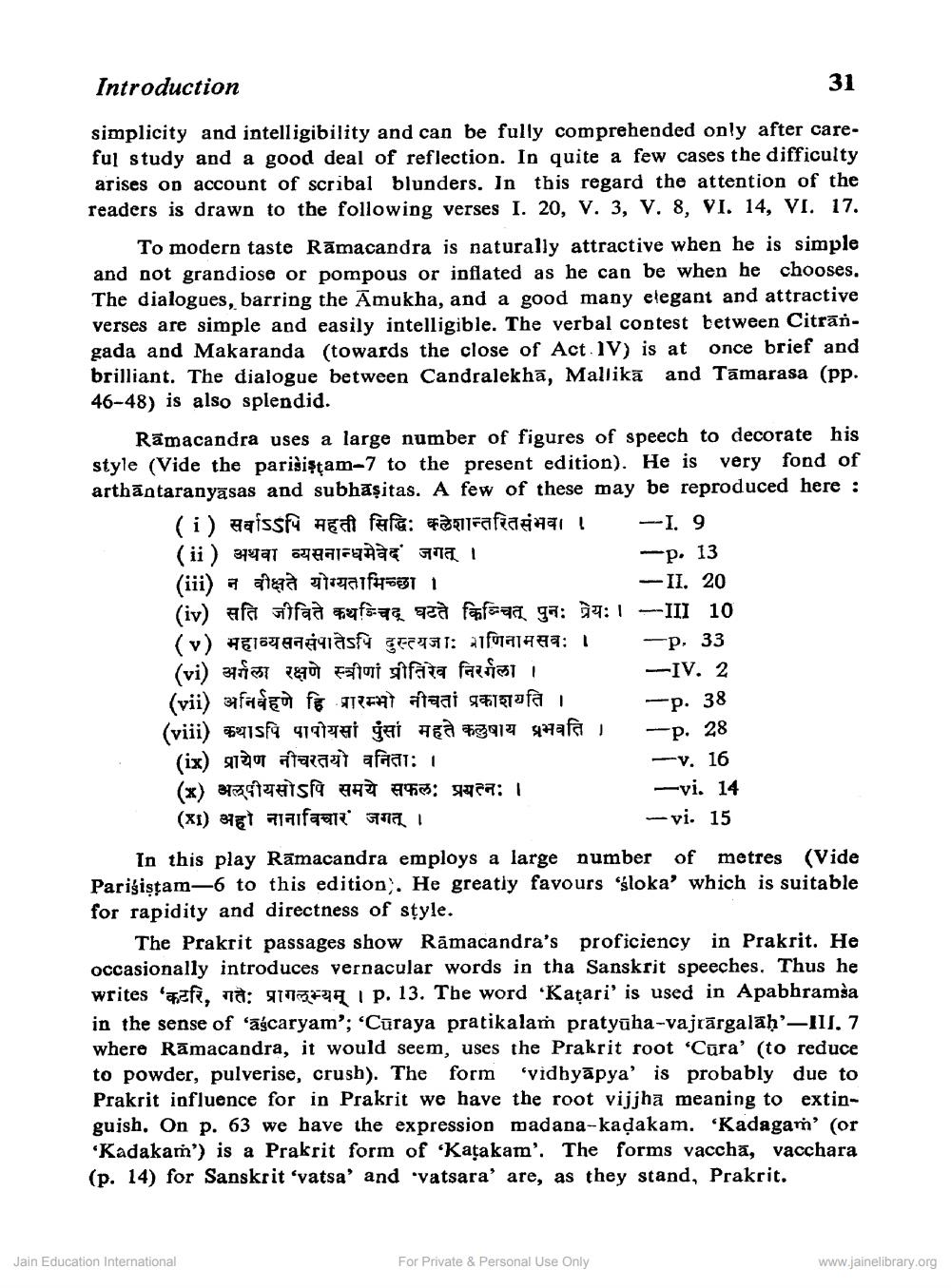________________
Introduction
31
simplicity and intelligibility and can be fully comprehended only after careful study and a good deal of reflection. In quite a few cases the difficulty arises on account of scribal blunders. In this regard the attention of the readers is drawn to the following verses I. 20, V. 3, V. 8, VI. 14, VI. 17.
To modern taste Rämacandra is naturally attractive when he is simple and not grandiose or pompous or inflated as he can be when he chooses. The dialogues, barring the Amukha, and a good many elegant and attractive verses are simple and easily intelligible. The verbal contest between Citrangada and Makaranda (towards the close of Act IV) is at once brief and brilliant. The dialogue between Candralekha, Mallika and Tamarasa (pp. 46-48) is also splendid.
Ramacandra uses a large number of figures of speech to decorate his style (Vide the parisistam-7 to the present edition). He is very fond of arthäntaranyasas and subhasitas. A few of these may be reproduced here : (i) सर्वाऽऽपि महती सिद्धिः क्लेशान्तरितसंभवा । (ii) अथवा व्यसनान्धमेवेदं जगत् ।
-I. 9
-p. 13
(iii) न वीक्षते योग्यतामिच्छा ।
II. 20 -III 10
(iv) सति जीविते कथचिद घटते किञ्चित् पुनः प्रेयः (v) महाव्यसन संपातेऽपि दुस्त्यजा: गणिनामसव: । (vi) अर्गला रक्षणे स्त्रीणां प्रीतिरेव निरर्गला । (vii) अनिर्वहणे हि प्रारम्भो नीचतां प्रकाशयति । (viii) कथाsपि पापीयसां पुंसां महते कलुषाय प्रभवति ।
-p. 33 -IV. 2 p. 38
P. 28 -v. 16 -vi. 14
-vi. 15
(ix) प्रायेण नीचरतयो वनिताः ।
(x) अल्पीय सोऽपि समये सफल प्रयत्नः ।
(x1) अहो नानाविचार जगत् ।
In this play Ramacandra employs a large number of (Vide Parisistam-6 to this edition). He greatly favours loka' which is suitable for rapidity and directness of style.
The Prakrit passages show Ramacandra's proficiency in Prakrit. He occasionally introduces vernacular words in tha Sanskrit speeches. Thus he writes af, n: 1 p. 13. The word 'Katari' is used in Apabhramia in the sense of "acaryam'; 'Caraya pratikalam pratyaha-vajtärgalaḥ'-III. 7 where Ramacandra, it would seem, uses the Prakrit root 'Cura' (to reduce to powder, pulverise, crush). The form 'vidhyāpya' is probably due to Prakrit influence for in Prakrit we have the root vijjha meaning to extinguish. On p. 63 we have the expression madana-kadakam. 'Kadagam' (or 'Kadakam') is a Prakrit form of 'Katakam'. The forms vaccha, vacchara (p. 14) for Sanskrit 'vatsa' and 'vatsara' are, as they stand, Prakrit.
Jain Education International
For Private & Personal Use Only
www.jainelibrary.org




